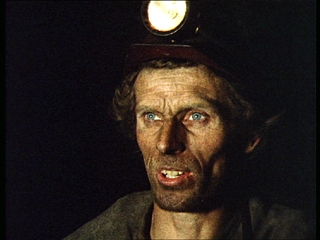High Row
 In Cumbria near Alston, a small drift mine was licensed from the Coal Board and worked by seven men, who had given up a variety of better paid jobs in exchange for a more independent working life. Burrowed deep into a hillside, with some of the seams only two feet high, the enterprise was commercially shaky, yet the men who endured physically hard and long working days, viewed their lives with certain affection, and even lyricism.
In Cumbria near Alston, a small drift mine was licensed from the Coal Board and worked by seven men, who had given up a variety of better paid jobs in exchange for a more independent working life. Burrowed deep into a hillside, with some of the seams only two feet high, the enterprise was commercially shaky, yet the men who endured physically hard and long working days, viewed their lives with certain affection, and even lyricism.
High Row observes a day in the life of the mine, using few words, but attempting to communicate something of the men's own vision of their lives in a rich texture of sounds and images. Having no commentary and no dramatic climax, the film recaptures the pace and rhythm of their working day, while creating a cinematic prose poem from the surreal, yet harmonious co-existence of grinding archaic machinery and unperturbed wildlife.
The film was scripted by observing, recording, and working with the men. They rejected an early script from the film makers: 'If it was like that, we wouldn't work here.' A script was then written with them. In order to have control over the events when filming in the cramped conditions inside the mine, the film makers proposed to rent the mine for a week, and paid the men to act out the script that reconstructed their working day.
In the early 1970s several Mobile Cinemas existed in the North East of England, touring local films, including High Row. Because of the local interest large audiences were drawn, this led to a series of discussions relating to issues raised by the films. One effect of the production of High Row for example was the interest taken by the miners' wives in the work process. Although the men consistently referred to work when at home the women had never been in a drift mine. The accuracy of High Row as a portrait of the miners' working day meant that the women had an insight into the miners' conditions for the first time. Some men said this was a factor in their giving up mining.
FULL SYNOPSIS
